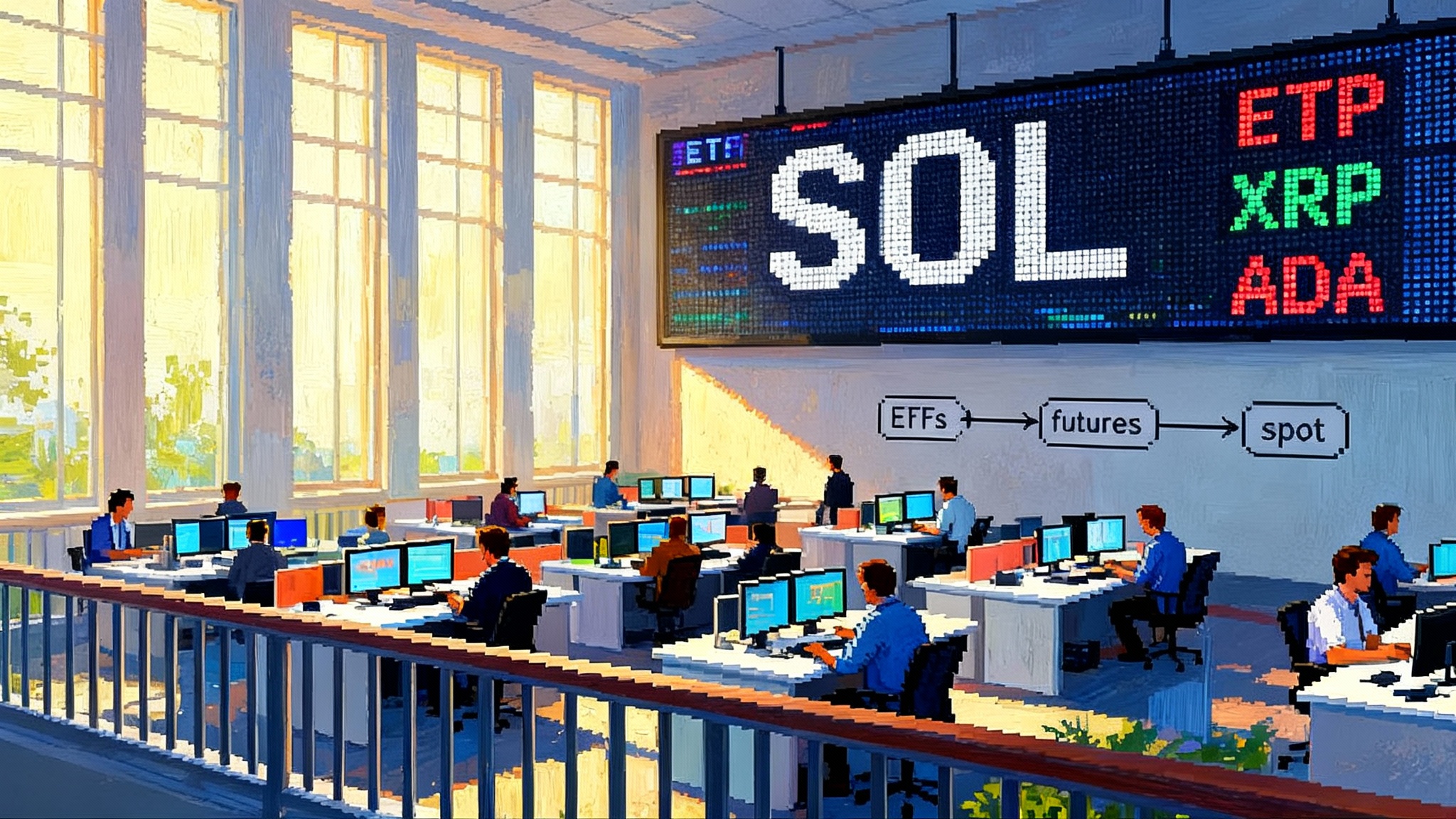SEC opens the gates: generic rules for spot altcoin ETFs
The SEC just approved generic listing standards that let NYSE, Nasdaq, and Cboe list spot crypto ETPs without case-by-case reviews. Here is what changed, which tokens likely go first, and how liquidity, custody, and DeFi could shift next.

The pivot that matters
In a single vote, the SEC replaced years of bespoke, one-off rule filings with a standardized on‑ramp for spot commodity ETPs that include digital assets. U.S. exchanges can now list qualifying spot crypto products under generic standards rather than waiting months for individual 19b‑4 approvals. That moves the market beyond a Bitcoin and Ether monoculture and toward a playbook that can scale across altcoins.
The practical impact is speed and predictability. Issuers that meet the new criteria can go straight to listing with exchanges, which in turn file a short notice within days of launch. The pipeline shifts from regulatory queuing to operational readiness.
If you remember how quickly the first wave of spot BTC and ETH products reshaped volumes, spreads, and investor access, you have a preview of what a broader menu could do across the rest of crypto.
What the SEC actually approved
The Commission okayed generic listing standards for Commodity‑Based Trust Shares on the three major U.S. equity exchanges. In plain English: if a spot commodity ETP checks a defined set of boxes, an exchange can list it without a bespoke SEC order.
Under the approval, a crypto ETP’s underlying asset must satisfy at least one of three eligibility paths. The SEC’s own statements outline them as follows: an asset qualifies if it trades on an Intermarket Surveillance Group member market; or it underlies a futures contract that has traded on a CFTC‑regulated designated contract market for at least six months with a surveillance‑sharing agreement in place; or, on an initial basis, there is an ETF listed on a national exchange that provides at least 40 percent exposure to that same commodity. The order also hardwires requirements for daily NAV, intraday indicative value dissemination, trading halt policies, market‑maker conduct, and website disclosures within five business days of trading. See the Commission’s statement on approval for the full criteria and mechanics. SEC statement on generic listing standards.
This is a structural shift. Two things change immediately:
- Exchanges become the primary gatekeepers for new listings under Rule 19b‑4(e), rather than the Commission vetting each product one by one.
- Issuers move from legal risk to execution risk. The bottleneck is no longer “Will we be approved,” but “Can we meet the standards, line up creation and redemption plumbing, disclosures, and surveillance links.”
Which tokens are likely first, and why
Expect the first wave to track where the six‑month regulated futures criterion is already satisfied or nearly there. That filter narrows the field fast.
-
Solana (SOL): Top candidate. SOL futures launched on a CFTC‑regulated exchange earlier this year and have now cleared the six‑month mark. That ticks the most straightforward eligibility box. Issuers already have index methodologies, reference rates, and creation baskets mapped. Timing: near‑term.
-
XRP: Next up. XRP futures began trading on U.S. designated contract markets in the spring. The six‑month clock is close to finishing. Depending on which DCM’s listing date an exchange relies on, initial XRP spot ETPs could slot in once that threshold is crossed. Timing: as early as late Q4 if operational pieces are ready.
-
The “near‑ready” cohort: Cardano, Litecoin, and others where regulated reference rates and some U.S. futures infrastructure exist or are being introduced. These move from speculation to scheduling once the six‑month DCM window is met and a surveillance agreement is in place. Where no regulated futures exist, a product needs either ISG‑member spot trading, which is rare for crypto today, or the bootstrap route via an ETF that is at least 40 percent exposed to the same asset, which in practice is a niche path.
Two practical screens will separate the truly first from the merely eager:
- Reference data and benchmarks. Assets with robust, manipulation‑resistant benchmarks and clear calculation agencies will move sooner.
- Liquidity depth across U.S. hours. Issuers, APs, and exchanges will prioritize tokens where primary liquidity is deep enough to support large creations without undue slippage.
What issuers must deliver
Generic does not mean loose. To list under the new standards, expect exchanges and their issuers to stand up the following, and quickly:
- Structure: A Commodity‑Based Trust Share that holds the underlying crypto, cash, cash equivalents, and in some cases commodity‑based derivatives for operational purposes. Not a 1940 Act fund.
- Eligibility of the commodity: Satisfy one of the three tests noted above, with documentation.
- Pricing and transparency: Daily NAV, an intraday indicative value published at short intervals, and public dissemination of holdings and valuation policies.
- Surveillance and halts: Surveillance‑sharing arrangements with relevant DCMs or ISG members and codified trading halt triggers if NAV, IIV, or reference asset dissemination is interrupted.
- Distribution standards: Minimum shares outstanding at launch and ongoing holder, float, and market value thresholds for continued listing.
- Market‑maker controls: Firewalls and position management for registered market makers, plus books and records access for the exchange.
- Website disclosures: Exchange posting of required product information within five business days of first trade.
Issuers that already launched BTC or ETH spot products have most of this muscle memory. New entrants will need to lift fast on custody selection, AP agreements, reference rate licensing, and basket operations.
How this reshapes liquidity
-
U.S. hours get busier. ETF share trading during cash equity hours pulls price discovery back into the day, while creations and redemptions transmit those flows to crypto venues and DCMs. For BTC and ETH we saw spreads compress and volumes cluster around U.S. mornings. Expect a similar pattern in altcoins that gain ETPs.
-
Benchmarks and futures basis matter more. With regulated futures serving as an eligibility anchor and a primary hedge, basis trading between ETP shares, spot, and DCM futures will scale. That tightens cross‑venue spreads and increases depth near benchmark fix windows.
-
AP balance sheets set the tone. On launch, borrow in the underlying may be scarce and expensive. Where staking or operational lockups reduce free float, creations can be lumpy. Expect transient premia and discounts that fade as borrow, lending, and internalization stabilize.
-
Volatility moderates in pockets, spikes in others. Daytime volatility should compress as two‑way institutional flow grows. But idiosyncratic squeezes are possible around rebalances, large creations, or if borrow gets tight. Options on the ETPs will eventually smooth that path.
Custody and staking implications
-
Concentration risk increases. A handful of qualified custodians are positioned to win mandates. Expect Coinbase Custody, Fidelity Digital Assets, BitGo, and Anchorage to compete on cold storage design, insurance layers, and audit cadence.
-
Staking policies will be conservative at first. For staking‑enabled assets like SOL, early products are likely to avoid staking until operational, tax, and asset‑segregation issues are buttoned up. That keeps ETF mechanics simpler but leaves native yield on the table. Over time, expect specialized staked‑share classes or parallel products.
-
On‑chain supply sinks. Spot ETPs trap float in cold storage. That reduces circulating supply available to DeFi pools and lending markets, which can nudge on‑chain yields up for remaining participants and increase the cost of borrow for market makers.
DeFi and cross‑ecosystem flows
-
TVL composition shifts. If ETFs capture passive buy‑and‑hold demand, DeFi retains the more yield‑sensitive and leverage‑seeking capital. That can increase the proportion of TVL in perps, options vaults, and liquidity provisioning strategies relative to vanilla spot pools.
-
Bridge and CEX on‑ramps get busier. Advisors and brokerage platforms route retail into ETFs. Arbitrage and hedging send those flows back into centralized crypto venues and DCM futures. Bridges see secondary effects as LPs rebalance across chains in response to price moves and yield changes.
-
Governance and protocol revenues. With more tokens immobilized in custody, active governance participation may dip unless ETP sponsors implement vote‑abstain policies or pass‑through mechanisms. Protocols that monetize order flow, MEV, or liquid staking may see a relative uptick in per‑unit revenues if float tightens.
How this compares to Europe’s MiCA world
MiCA is about tokens and service providers. It harmonizes disclosures, authorizations, and market abuse controls for crypto issuers and CASPs across the EU. It is not a product‑by‑product ETF approval regime. Europe already lists a wide array of crypto ETPs under existing exchange rules, while MiCA sets the perimeter for custody, market integrity, and consumer protection. Key dates matter: stablecoin rules began June 30, 2024, and the rest of MiCA applied from December 30, 2024. See the EU’s legal summary for scope and timing. EU summary of MiCA application dates.
Bottom line: Europe built a harmonized crypto market conduct framework first, then let exchanges keep listing ETPs. The U.S. took the opposite path. It greenlit broad generic listing rails for spot commodity ETPs and will rely on exchange rules, surveillance links, and existing securities laws to police products. The end state is similar access, via very different routes.
Likely winners and losers
Winners
- Exchanges: Cboe BZX and NYSE Arca have a track record with crypto listings and dense issuer relationships. Nasdaq is incentivized to compete hard on speed, surveillance integrations, and issuer services.
- Market makers and APs with cross‑venue pipes: Firms with connectivity across equities, crypto spot, and DCMs will own the creation‑hedge‑redeem loop. Expect leaders in ETF market making and crypto liquidity provision to capture share.
- Qualified custodians: The few with SOC‑audited cold storage, battle‑tested key management, and insurance capacity will see mandates cluster.
- Index and benchmark providers: Regulated, manipulation‑resistant rates are the oil in this engine. Providers with deep constituents, resilient methodologies, and fallback procedures gain licensing revenue and mindshare.
- Token ecosystems with regulated futures and deep U.S. liquidity: SOL is first in line. XRP follows on futures tenure. Assets next in the DCM queue ride the second wave.
Relative losers
- Tokens without a regulated futures pathway: Without a DCM track record or ISG‑member spot trading, the generic standard is hard to meet. These assets will lag despite strong on‑chain activity.
- Smaller custodians and single‑venue market makers: Scale, audits, and surveillance links are now table stakes.
- Off‑shore only venues: As more liquidity migrates to U.S. cash hours and DCM hedges, purely off‑shore perps venues may see some relative share bleed for eligible assets.
A near‑term playbook
For traders
- Map the six‑month futures clocks. Build a calendar by asset and DCM. The closer to day 180, the higher the odds you see filings, seed flows, and market‑maker setup trades.
- Watch borrow and funding. Early creations are constrained by borrow, settlement cycles, and AP risk limits. Premia and discounts around launch are opportunities, but position sizes should respect those frictions.
- Trade the basis triangle. ETP share versus spot versus DCM futures is the core triangle. Add options when they list. Expect basis to tighten as inventory circulates and as options provide convexity supply.
- Pair the likely with the listed. When SOL goes live, watch relative performance in the hours around U.S. open against a basket of near‑eligible assets. Rotation trades often over‑ and under‑shoot on day one and day two.
- Respect microstructure. Rebalance windows, index fix times, and primary creation cutoffs will matter more than narratives. Build alerts around them.
For builders and token teams
- Get the data layer audit‑ready. Lock in reference rate licensing, fallbacks, and dissemination SLAs. Exchanges will scrutinize this.
- Pre‑wire surveillance and disclosures. If your asset’s path is via the futures criterion, coordinate with the DCM and exchange on surveillance‑sharing language. Prepare clear risk factor disclosures, IIV methodologies, and NAV policies.
- Choose your custody stack now. Segregation model, insurance, MPC or HSM design, warm versus deep‑cold flows, audit cadence. Issuers will not wait for you after the green light.
- Decide on staking policy early. If staking is on the roadmap, map legal, tax, and operational paths before launch. If it is not, say so and explain why. Markets price policy uncertainty.
- Build AP and seeding relationships. Two or three high‑quality APs and a handful of liquidity providers are worth more than a long tail. Run dry‑runs of creations, redemptions, and T+1 cash wires.
- Engage on governance. If large balances will sit in cold storage, set expectations around voting, delegation, or abstention. Consider neutral policies to avoid governance churn.
What to watch next
- Final S‑1 effectiveness and exchange notices. The new regime condenses timelines, but S‑1 readiness, distributor agreements, and seed capital still gate launch dates.
- Options listings. Options on the ETP shares materially improve hedging and reduce volatility around creations. Expect them shortly after liquid trading is demonstrated.
- Index products. Broad market or sector index ETPs can list under the same rails if constituents meet eligibility. Those can accelerate flows into a small set of high‑liquidity names.
The floodgates are open, but the flow will still follow the trenches of regulated futures, robust benchmarks, and operational readiness. If you are positioned where those three meet, the next phase of crypto’s integration into U.S. capital markets just arrived on your desk.


